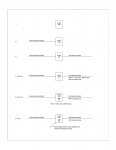- Location
- Connecticut
- Occupation
- Engineer
BTW, I'm not buying the argument that 215.3 figures into this issue at all. 215.3 is for feeder overcurrent protection, not service conductor overcurrent protection. The mathematics may eventually relate 215.3 to 230.90 but there is no specific link either implied or stated in the Code that I am aware of between the two.
Unfortunately, I am not somewhere where I could draw a picture an post it, but here is a simple exercise with less than 10 steps that illustrates my point...
1) Grab a piece of paper and draw a square in the center. Label the square "Service OCPD."
2) Draw a line segment leaving the left side of the square. Label this "Service Conductors."
3) Draw a line segment leaving the right side of the square. Label this "Main Feeder."
4) Indicate a load of 100A non-continuous plus 100A continuous for the Main Feeder, look under 215.2 and find that the main feeder size must have an ampacity of 225A. #4/0 meets this size requirement, so label the main feeder as #4/0 conductors.
5) Look under 215.3 and finder that the OCPD protecting the feeder must have a min size of at least 225A. Write 225A in the square as the size of the OCPD protecting the feeder conductors.
6) Sit back and celebrate your "A-ha" moment.
Much shorter than 10 steps.

